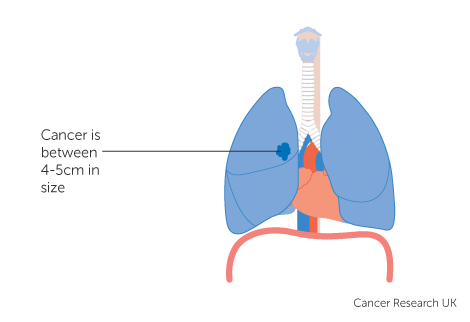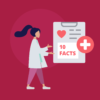39-year-old Ms Noor Azlin Abdul Rahman won a legal case against Changi General Hospital (CGH) for negligence which resulted in a delayed diagnosis of her early stage lung cancer. It was argued that if the hospital had undertaken a more systematic approach and followed-up on the “opacity” detected in her lungs from 2007 to 2011, it would have been “unlikely that the lung cancer would have progressed to Stage IIA.”
Lung cancer is the third most common cancer among women in Singapore. According to the Singapore Cancer Society, patients have a much higher chance of survival if it is detected in the early stages, although it also depends on other factors such as the patient’s age, diet, genetic disposition, and other lifestyle habits.
In Ms Noor’s case, her lung cancer was finally diagnosed at Stage IIA, which is defined as a tumour between 4cm to 5cm, that has not spread to nearby lymph nodes. Sometimes, the tumour can be removed surgically, or partially, followed by other treatments.
She passed away in April 2019, 5 weeks after she won the case.

What are the Signs of Lung Cancer and How Can It Be Screened?
Although early stages of lung cancer often has no symptoms, there are some common tell-tale signs that may raise red flags for those at higher risks, such as smokers:
- General weakness, tiredness, and unexplained weight loss
- Persistent coughs that worsen over time
- Blood in sputum (phlegm)
- Shortness of breath, wheezing, or hoarseness
- Recurring chest infection and fever
- Constant chest pain
- Loss of appetite
Lung cancer screening is usually done via a low-dose CT scan, which provides a 3-dimensional image of the lungs that may indicate the presence of abnormalities or tumours. Following which, the doctor may order blood tests or perform a lung biopsy to detect the presence of cancer.
Even though the above symptoms may be signs of other diseases and not necessarily indicative of lung cancer, screening may be recommended to individuals with higher risks, such as those who smoke or have a family history of lung cancer.
Lung Cancer can be subdivided into Non-Small Cell Lung Cancer (NSCLC) and Small Cell Lung Cancer (SCLC).
Treatment Options for Lung Cancer and Side Effects
Equipping yourself with knowledge of lung cancer treatments and their side effects will help you better prepare for the caregiving needs of your loved ones. Ensuring that your loved one has adequate rest during the treatment period, will help with managing some of the side effects.
Side effects of lung cancer treatments should gradually fade off once treatments have been completed.
The suitability of a lung cancer treatment plan will differ depending on the progression of the cancer, the patient’s age, medical history and overall health.
Surgery, alongside with radiotherapy may result in a higher cure rate for Non-Small Cell Lung Cancer in stage I and II, since it tends to grow and spread slowly.
For stage III Lung Cancer, radiation therapy is recommended, and may be combined with chemotherapy.
For stage IV Lung Cancer, chemotherapy or targeted therapy may be needed, although the treatment is mainly palliative, such as pain relief, providing blood transfusion to cope with blood loss, and treating obstruction to the veins.
Small Cell Lung Cancer is usually aggressive and tends to spread early to other organs, which is why chemotherapy is usually the recommended treatment option. If the lung cancer is found to be localised to the lymph nodes of only one lung, chemotherapy may be combined with radiotherapy.
Surgery for Lung Cancer
Surgery involves the removal of the tumour for Non-Small Cell Lung Cancer. It is usually not recommended for Small Cell Lung Cancer.
Sometimes, part of the tumour will be removed by surgery, and the remaining will be treated via chemotherapy. Chemotherapy may also be recommended after surgery for cancer in the early stages to prevent recurrence.
Radiation Therapy (or Radiotherapy) for Lung Cancer
High energy rays are used to destroy cancer cells at a targeted part of the body. Normal non-cancerous cells around the area may be damaged, thus you may expect side effects that include loss of appetite, tiredness, and changes to the skin such as redness or rashes.
Medication may be prescribed to relieve the skin condition. As a caregiver, you may also plan nutrition-rich meals in small portions for your loved one, and be prepared if the patient is unable to eat.
Chemotherapy for Lung Cancer
Chemotherapy involves the use of potent drugs, administered via injections or taken orally in pills or liquid. While chemotherapy aims to destroy cancer cells, it is also expected to destroy normal cells in the process, which may cause nausea and vomiting that can be managed by medication. Other side effects include hair loss and tiredness.
Targeted Therapy for Lung Cancer
Molecules that are involved in the growth and spread of cancer are blocked via drugs or substances in targeted therapy. Common side effects of targeted therapy for lung cancer are diarrhoea and liver problems, such as hepatitis.
Other side effects of targeted therapy include:
- Skin problems such as rash, dry skin, nail changes, changes in hair colour;
- Problems with blood clotting and wound healing;
- High blood pressure
- Rarely, gastrointestinal perforation, or a hole in the wall along the gastrointestinal system
How to Support a Loved One Undergoing Treatment for Lung Cancer
Caregivers should familiarise themselves with the likely side effects of the treatment, which can be discussed with the doctor. From there, steps can be taken to help your loved one manage the side effects, whether through medication, dietary changes or even preparing your home and lifestyle to support the patient.
As a caregiver, your responsibilities may include:
- Giving medications
- Coordinating medical appointments
- Managing and keeping track of side effects during the treatment(s)
- Handling the medical bills and insurance claims
- Planning of meals
- Helping out with household chores
- Providing emotional support and encouragement
Sometimes, providing adequate home care during the treatment process of lung cancer can be a challenge for caregivers. This is especially so if you are trying to balance caregiving of a family member diagnosed with Lung Cancer, while maintaining your daily activities such as going to work and other family or social responsibilities.
Jaga-Me aims to support your loved one through their Lung Cancer treatment with quality home-based care by our professional nurses. Send us a message to find out more on how we can help you and your loved one with their recovery.
References:
- Stolarchuk, Jewel (2019, April 1). Cancer-patient who sued CGH for medical negligence for 12 years and won, passes away. Retrieved from http://theindependent.sg/cancer-patient-who-sued-cgh-for-medical-negligence-for-12-years-and-won-passes-away/
- Chai Chin, Neo (2019, Febuary 27). Changi General Hospital’s negligence caused delay in lung cancer patient’s diagnosis: Apex court. Retrieved from https://www.todayonline.com/singapore/changi-general-hospitals-negligence-caused-delay-lung-cancer-patients-diagnosis-apex-court
- Singapore Cancer Society (2016). Lung Cancer. Retrieved from https://www.singaporecancersociety.org.sg/learn-about-cancer/types-of-cancer/lung-cancer.html
- American Society of Clinical Oncology (2018, March) Stages of Cancer. Retrieved from https://www.cancer.net/navigating-cancer-care/diagnosing-cancer/stages-cancer
- Cancer Research UK (2017, August 1). Stage 2 Lung Cancer. Retrieved from https://www.cancerresearchuk.org/about-cancer/lung-cancer/stages-types-grades/stage-2
Jaga-Me: Your Trusted Medical Home Care Professional




